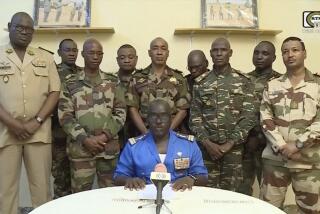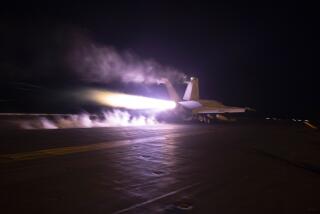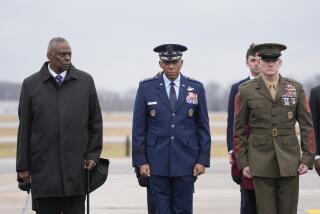U.S. targets Al Qaeda, Shabab leaders in Libya, Somalia
WASHINGTON — U.S. forces conducted raids in Somalia and Libya on Saturday targeting suspected militant leaders, including one tied to the 1998 bombings of the U.S. embassies in East Africa.
In an unusual operation in Tripoli, the Libyan capital, U.S. forces captured a suspected Al Qaeda leader wanted in connection with the bombings 15 years ago of American Embassies in Kenya and Tanzania, a U.S. official said.
The suspect, who goes by the name Abu Anas al Liby, was one of the FBI’s most wanted fugitives, with a reward of up to $5 million on his head. In 2000, he was indicted by a federal grand jury on charges that he was involved in planning the embassy attacks.
“As the result of a U.S. counter-terrorism operation, Abu Anas al Liby is currently lawfully detained by the U.S. military in a secure location outside of Libya,” Pentagon Press Secretary George Little said in a statement late Saturday.
In Somalia, Navy SEALs carried out a predawn raid against a suspected Shabab leader who is believed to have planned the group’s deadly attack last month on a shopping mall in Kenya, U.S. officials said.
A U.S. official said the Somalia raid involved commandos storming a beachfront house in a town not far from Mogadishu. It remained unclear whether the target of the raid was killed or was even present.
“At this point we can’t confirm his status. He may not have been there, or could have been killed or injured,” another U.S. official said.
Little confirmed that “U.S. military personnel were involved in a counter-terrorism operation against a known Al Shabab terrorist,” but declined to provide more details.
A senior U.S. official said the operation was aimed at capturing a senior Shabab leader. The SEALs broke off the attack “after inflicting some Al Shabab casualties,” the official said. He added that the U.S. could not identify the casualties. No U.S. personnel were injured or killed in the raid, the official said.
The Somalia operation was one of the most significant by the U.S. military in that country in years and it indicates that the Obama administration considers the Shabab, a militant group that pledged allegiance to Al Qaeda, a growing threat to the U.S. and its allies in Africa. The group claimed responsibility for the Sept. 21 attack at a Nairobi shopping mall that left almost 70 people dead.
The raid also points to a growing willingness to put U.S. troops in the country to fight the Shabab after years of trying to contain the threat by using drones and by backing African troops sent to Somalia in an effort to stabilize the war-torn country.
One of the officials said the location of the Shabab leader was recently pinpointed by intelligence intercepts, part of a growing effort to track the group’s senior ranks using surveillance drones, electronic intercepts and contacts with friendly Somali clan leaders.
The raid was approved by President Obama after he was briefed on the intelligence, the official said.
For years, the U.S. has avoided putting troops in Somalia, a vestige of the bloody battle 20 years ago in Mogadishu when 18 Americans were killed and two Black Hawk helicopters were shot down.
The raid Saturday was the first major U.S. attack since Aden Hashi Ayro, the Shabab’s leader, was killed in 2008 by a drone strike on his house.
Pushed out of territory in Somalia it once controlled and riven by internal dissent, the Shabab has long been seen as a dangerous regional threat. But it has not demonstrated the inclination or capability to attack the U.S. homeland, as Al Qaeda’s affiliate in Yemen has tried to do, officials say.
U.S. counter-terrorism operations in Somalia have been far less frequent than those targeting Al Qaeda militants in Pakistan and Yemen. A single U.S. drone strike was reported last year in Somalia and none this year, according to the Bureau of Investigative Journalism, a London-based advocacy group that tracks U.S. drone attacks.
Also on Saturday, Kenyan security officials named four of the terrorists who attacked the Nairobi shopping mall and released closed-circuit television video of four gunmen walking calmly through the mall, talking on cellphones and carrying heavy guns.
The video aired on Kenyan television showed the gunmen walking around the mall and a limited section of the complex. Attacks on civilians were not shown.
Kenyan police said the number of people involved in the attack was four to six, not the 10 to 15 earlier estimated. Kenyan Police Chief David Kimaiyo said none of the attackers managed to escape the building and all had been killed. His comments contradict at least one witness’ account of seeing the men mingling with the crowd escaping from the mall.
There were no Westerners among the gunmen, as earlier accounts had indicated, Kenyan police said, and several appeared of the men to have had terrorism training. .
The four names released Saturday were Abu Baara al Sudani, described by Kenyan police as the leader of the group and an experienced fighter; Omar Nabhan, said to be a Kenyan of Arab origin; Khattab al Kene, described as a Somali extremist linked to the Shabab with experience in explosives and firearms; and a man whose name was given only as Umayr.
Times staff writers Robyn Dixon in Johannesburg, South Africa, and Ken Dilanian in Washington contributed to this report.
More to Read
Start your day right
Sign up for Essential California for news, features and recommendations from the L.A. Times and beyond in your inbox six days a week.
You may occasionally receive promotional content from the Los Angeles Times.







